
At this point, you’re ready to leave the Metallic Ore section, and move into the section on Non-Metallic Ores. They come from Eastern Canada (Labrador to Ontario). The Non-Metallic Ores, in general, tend to be less spectacular than many of their Metallic cousins. However, they are in big demand and supply many of the raw materials so essential in today’s society. As you have already seen, some pedestals are empty along the route, and this is to give room for expansion as new samples become available. Please note that these samples are on both sides of the trail! (They were randomly placed over time, so number codes also appear random…some to the left and some to the right.)
NMO#1
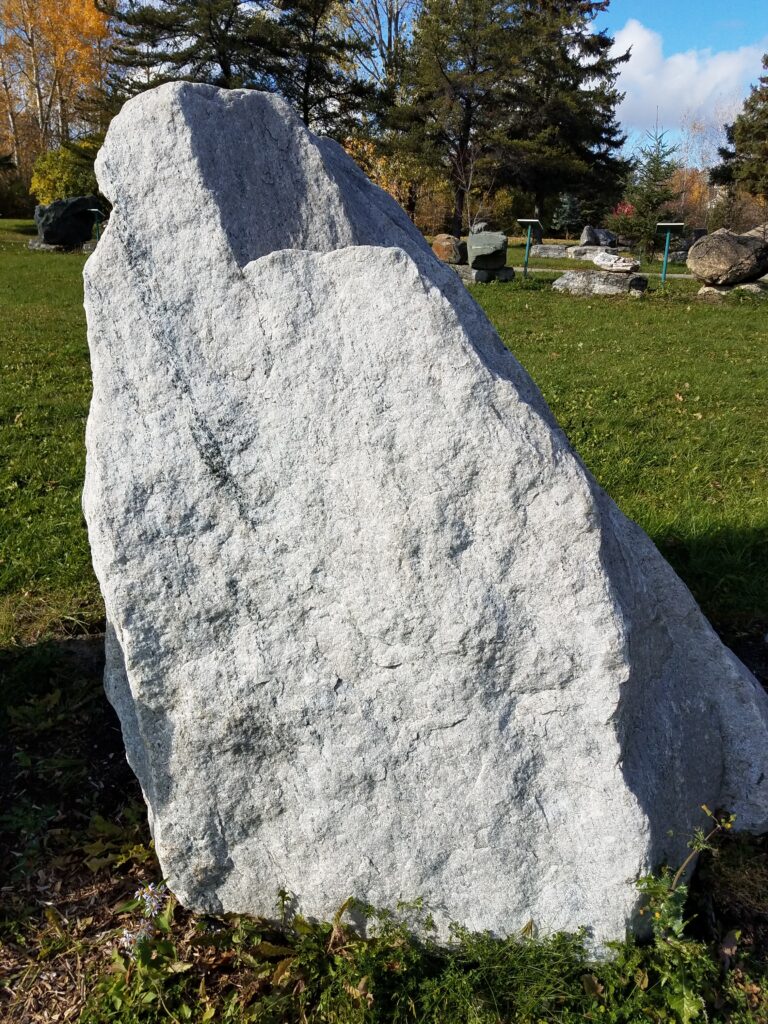
The sample of Nepheline Syenite comes from the Nephton mine (closed in 2020) in the Unimin deposit near Havelock, Ontario. The actual rock type here is ‘syenite’, whereas the ore mineral is ‘nepheline’. Because of its high alumina content, nepheline has been used in place of feldspar in the glass industry. It is also used for a flux in making ceramics, and as filler in paint, caulks, sealants, adhesives and polymers. The mine originated in 1935, and a number of quarries were developed, but the Blue Mountain quarry will expand into the future.
Internet video…seek: Home/Canadian Nepheline Modernization – Covia
NMO#2
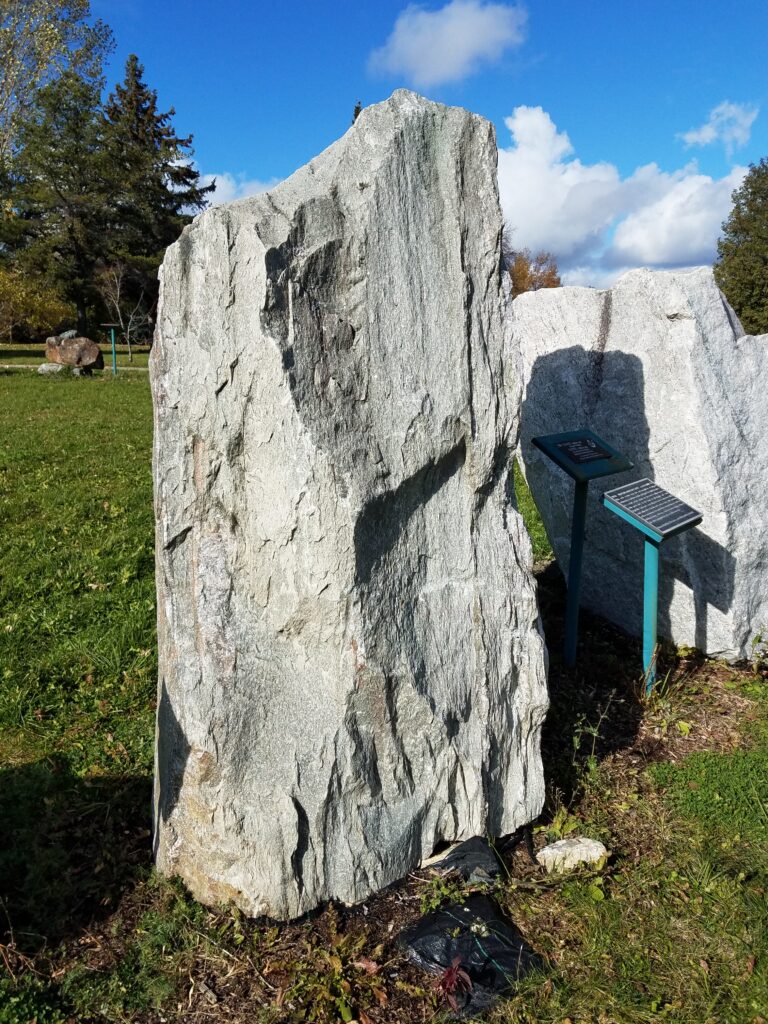
This huge sample is essentially quartzite layered with seams of greenish mica. Because of its satiny appearance, this material makes a desirable dimension stone for tiles, facing slabs, and mantles in building construction. It is also used for landscaping stone, such as at the front of restaurant chains. This sample comes from the quarry operations of Habex Resources near the south end of Lake Timiskaming on the Ontario side. Three more samples are in our “Gem Garden”.
Signage provided by Habex Resources, located near McLaren Bay, ON.
NMO#3A
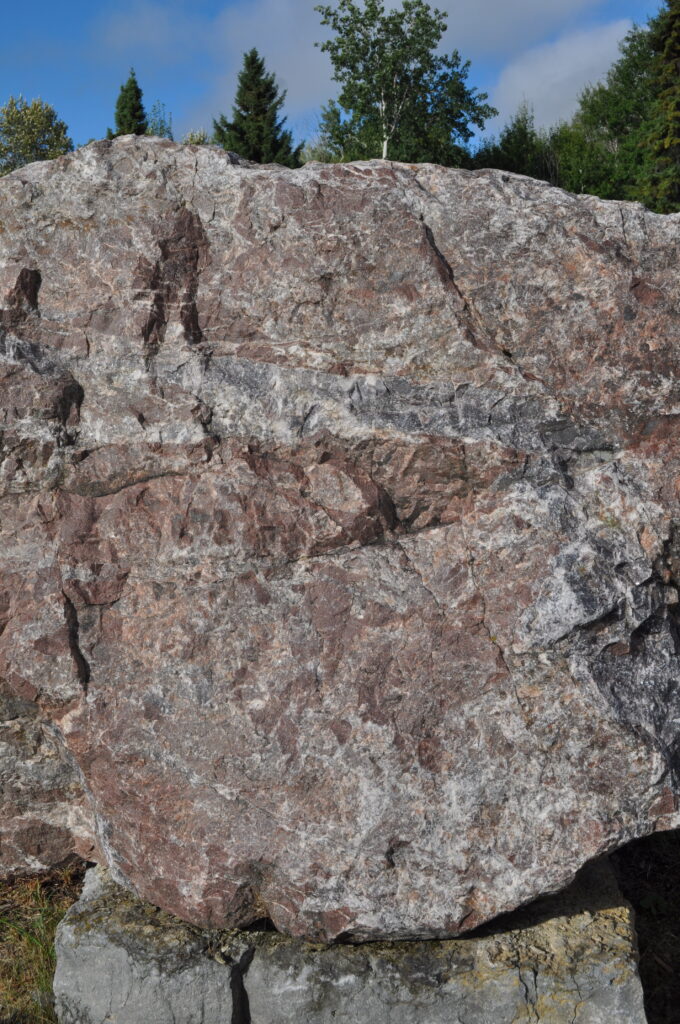
This large block of low grade Barite ore came from the Glendinning Mine on the shoreline of Mistinikon Lake in Yarrow Township, south of Matachewan, Ontario. Barium Sulphate was found as a ‘fracture filling’, up to 14 feet wide, cutting through the Cobalt Group meta-sediments. Discovered in 1917, the deposit held 10 other minerals including bornite, chalcopyrite, hematite and marcasite. In this sample, the white material is the barium source while the red rock is waste. Extender Minerals milled and sold the product to manufacturers of brake linings, paints, plastics, and mold lubricants until 2001.
Signage sponsored by Laframboise Drilling Inc. (Earlton, Ontario)
Internet pictures…seek: Photo Gallery Glendinning Mine Yarrow Twp.
NMO#3B
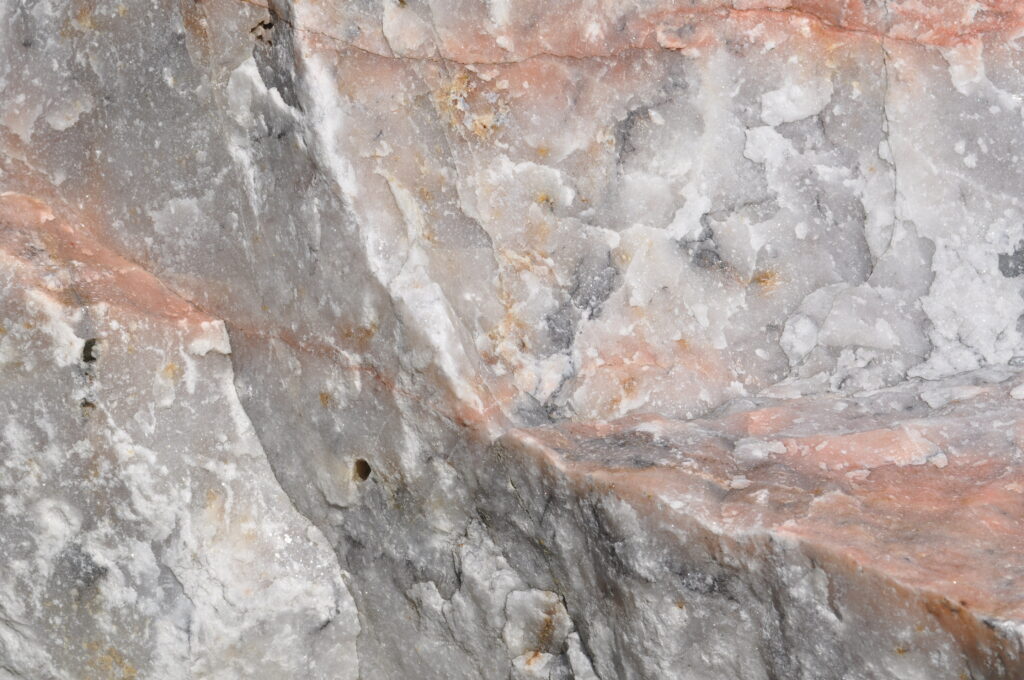
This is high-grade white barite from a site near Shining Tree. The mineral barite is composed of barium sulphate, and because of ‘heaviness’ makes an ideal substance for use in drilling muds, radiation screens, and barium radiography ‘milkshakes’. Extender Minerals also mined this site.
Signage sponsor: Alvin Caldwell Sand & Gravel (New Liskeard, ON)
Internet Report seek: MNDM Geology Ontario Williams Barite Deposit
NMO#4
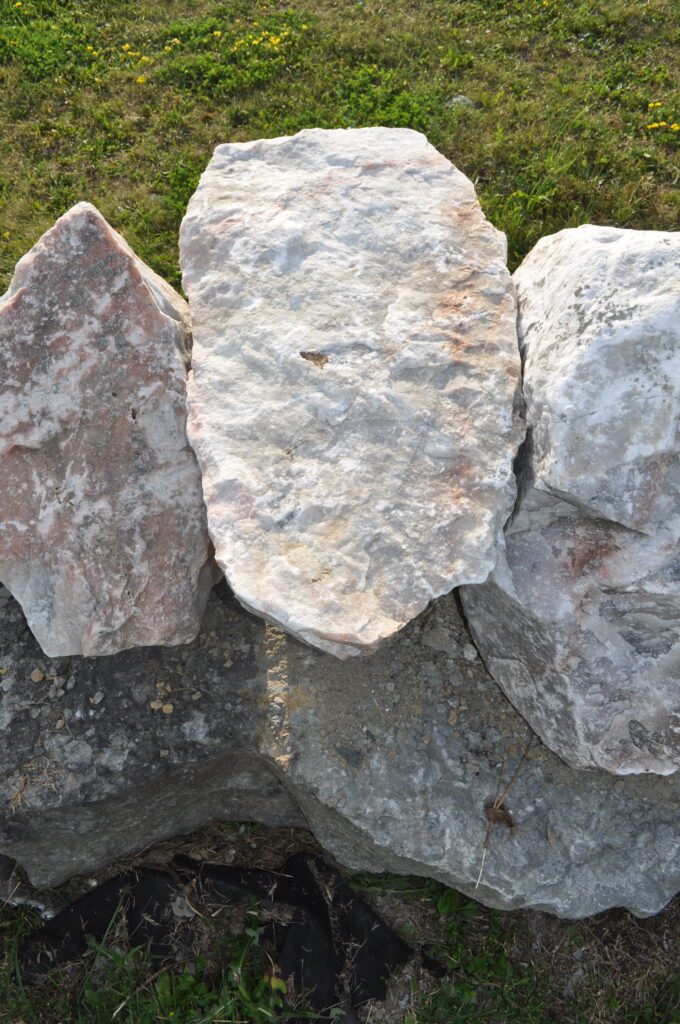
This sample is from the 1918 Biederman Barite prospect, on the shore of Browning Lake, Cairo Township (near Matachewan) and contains white barite in syenite, with “impurities” of purple Fluorite (calcium floride). Fluorite is an ore of fluorine, used, for example, to fluoridate water supplies, make hydrofluoric acid (a very strong acid used in many industrial processes), and provide a flux in the manufacture of steel. It can occur as a gangue mineral in veins with ores of lead, silver, and zinc. Fluorite has some notable properties, including the ability to cleave in perfect cubes or octahedrons, and with a hardness of 4 on Moh’s Scale, it is a standard point of reference. The mineral can appear as purple, green, blue, and yellow specimens.
Internet photos…seek: Fluorite
NMO#5
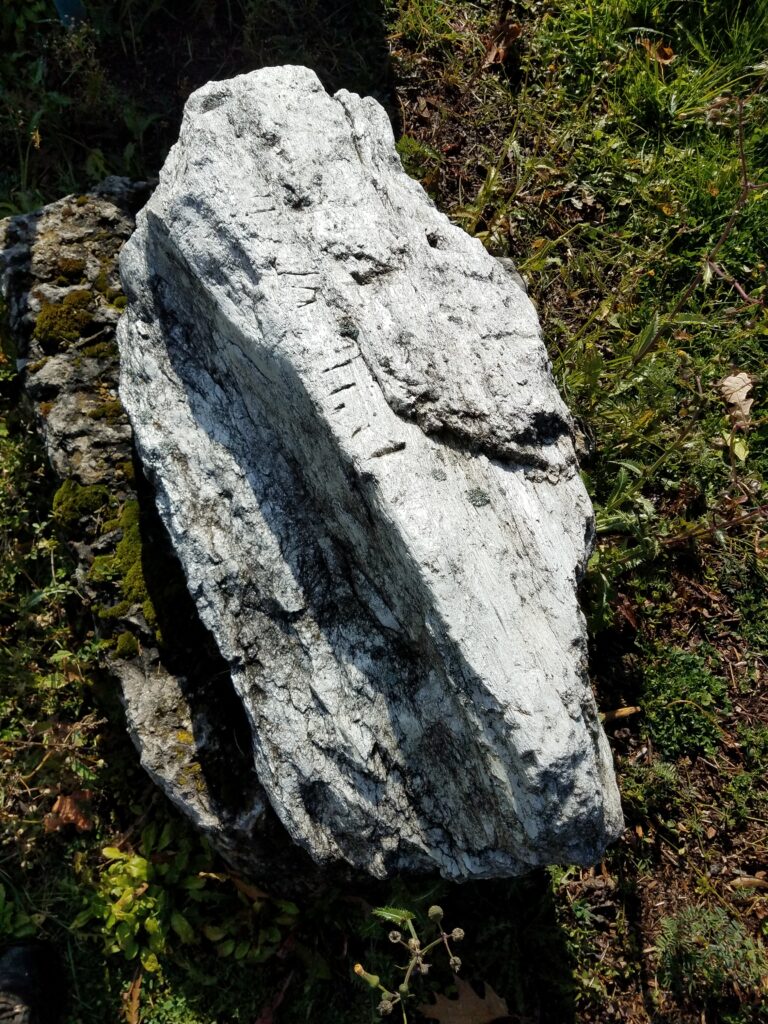
Talc was produced from the Canada Talc mine at Madoc, Ontario, it was discovered in 1881, and mining began in 1896. It was the oldest mine in Canada, continually operational until it was closed in 2010. At that time, this exhibit was sent to RockWalk Park. The talc occurred in dolomitic marble as a hydrothermal replacement body. The original…and largest zone was a tabular sheet of high purity (50-60%) white talc, 10 to 60 feet wide, and 900 to 1000 feet long. Talc is a mineral composed of 31.7% magnesium oxide, 63.5% silicon dioxide, and 4.8% water.
Internet obituary…seek: When a mine closes – The Globe and Mail 2010
NMO#6
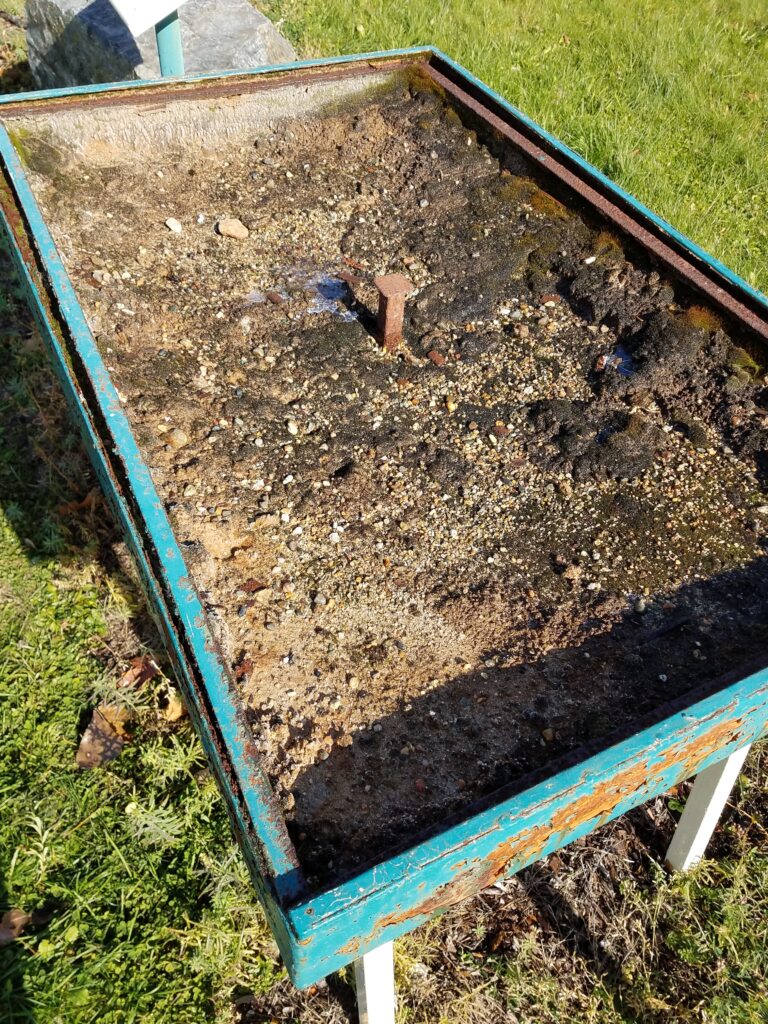
This sample is found in the green box located across the path from the barite samples. Here, the material originally looked like mud or muddy sand … and to some extent it is, although it looks a lot like cement. The mineral composition is essentially apatite, and as such it makes up phosphate ore. Note that moss and lichen are colonizing the sample around the inside edges of the box. Phosphate is mainly used in the manufacture of fertilizer, but the salts are also used to make phosphoric acid and phosphorus. This material comes from the Agrium phosphate deposit west of Kapuskasing, Ontario. Note the red leachate under the box.
Internet pictures…seek: Paul Lantz Agrium Phosphate Mine 2012
NMO#7
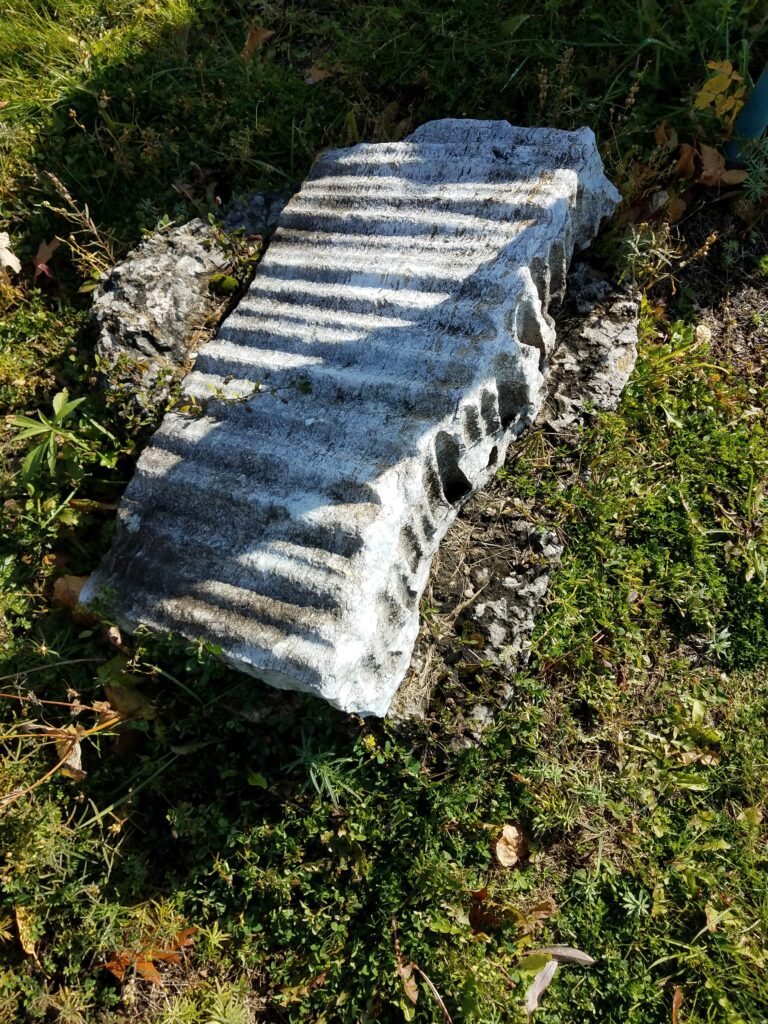
This sample is of Eastern Ontario marble. Marble (Calcium Carbonate) is essentially limestone that has been metamorphosed. Marble (e.g. the world famous Carrara marble from Italy) is used for dimension stone, flooring, sculpture, etc. the world over. As an example, the large pieces used in our donor’s wall are of this material, and come from the Tatlock marble quarry in Lanark County, formed 1.255 Ga by shells of small fossilized snails, shellfish, and coral an a warm, shallow marine environment. The deposit was later subjected to high temperatures and pressures from volcanic activity that caused the deposit to be metamorphosed. As such, the calcite grains are no longer held together by calcite cement, but are instead fused (or “welded”) together from heat and pressure.
Internet geology session…seek: Tatlock marble quarry – Duelsport Diary
NMO#8
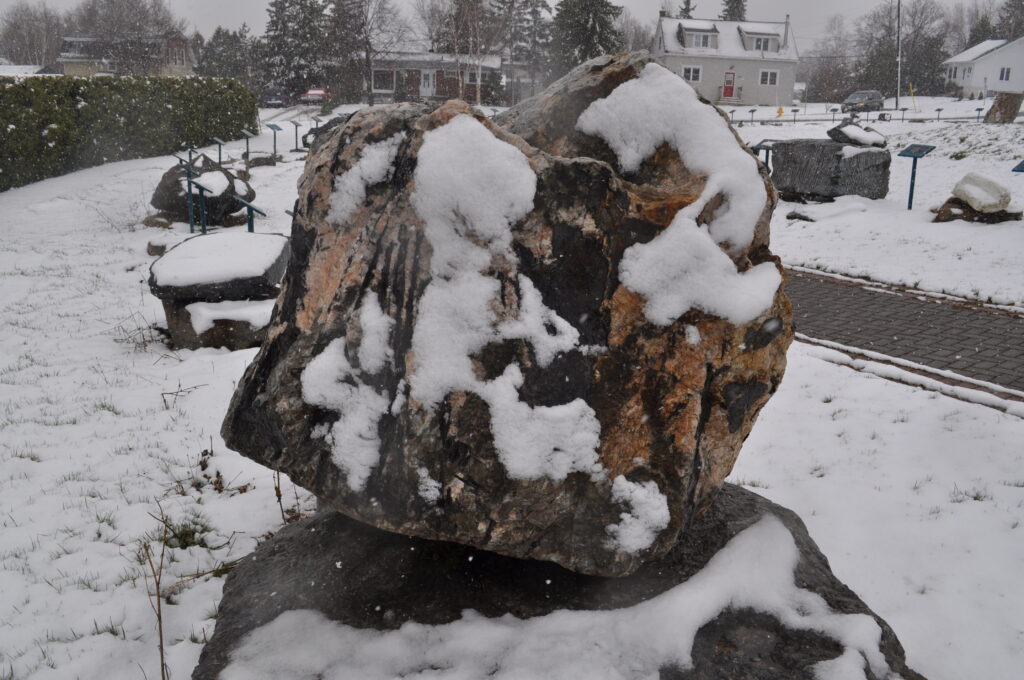
Selected from a highly visible Pegmatite Dike in a rock cut at Km. 249-250 on Hwy.#11, just south of Katrine, this exhibit features pink (orthoclase) feldspar, black (biotite) mica, and even red (almandine) garnet. This is an intrusive rock with large crystals, developed deep underground and slowly cooled in the final stages of magma crystallization. The rock composition is chemically identical to granite. Pegmatites are economically important as a source of Lithium, rare earth minerals, and gemstones such as topaz, corundum, aquamarine, tourmaline, and fluorite.
Display Sponsor: Dawson Gambles, B.N.Sc. (Queen’s University)
Internet Ontario report seek: MNDM Geology Ontario pegmatite minerals
NOTE: at this point, move to the opposite side of the trail to see 1 exhibit (only)…
NMO#13
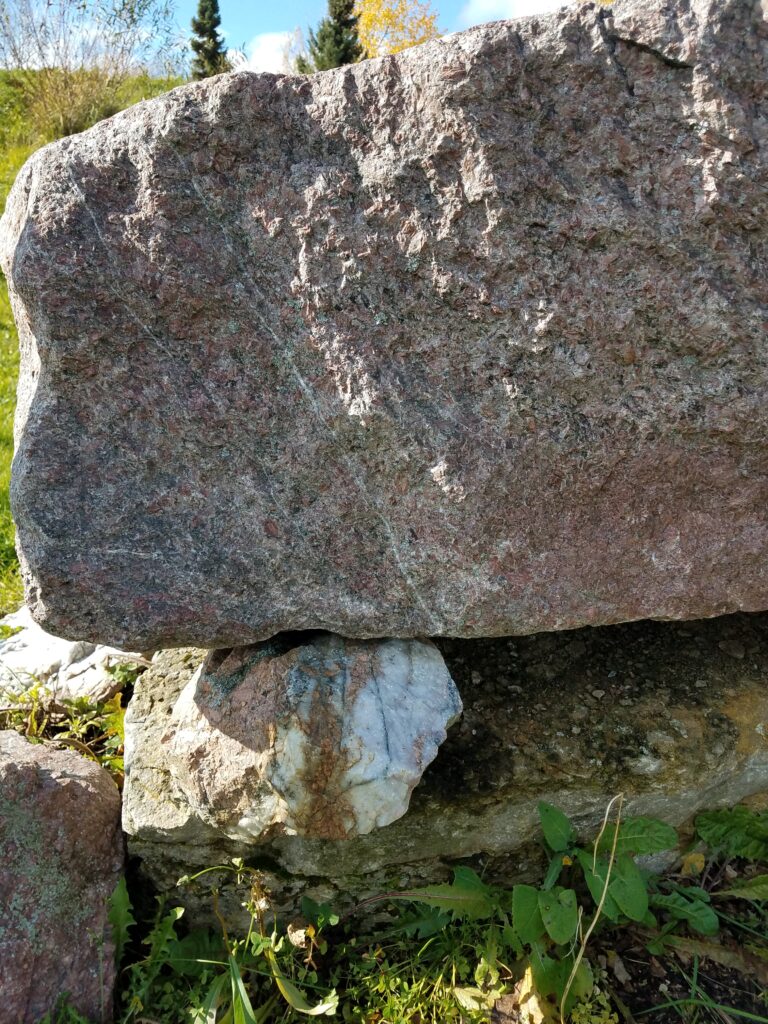
If you get a chance, be sure to watch for a night tour of the park. This is one of the samples that contains minerals that fluoresce under short wave ultraviolet light. In this case the mineral is Scheelite, one of the principal ores of tungsten (used for example, to make electrodes, lights, tough steel alloys). The scheelite makes up the narrow white veinlets that cut through the granitic host rock. The host rock, by the way, gives an excellent opportunity to see well-formed feldspar crystals. These samples come from the Iris deposit of Gwen Resources, north of Esker Lakes Provincial Park, near Kirkland Lake. The property was developed as a gold prospect, but the scan of the adit with a short-wave ultraviolet light identified the presence of Scheelite with its bluish-white florescence. Our best examples are secure under the large cap-stone block that has localized Scheelite.
Display Sponsor: Chandel Gambles, B.A. (University of Guelph), B.Ed. (Queen’s University)
Internet Underground tour seek: A tour of the Cantung mine – You Tube
NMO#14
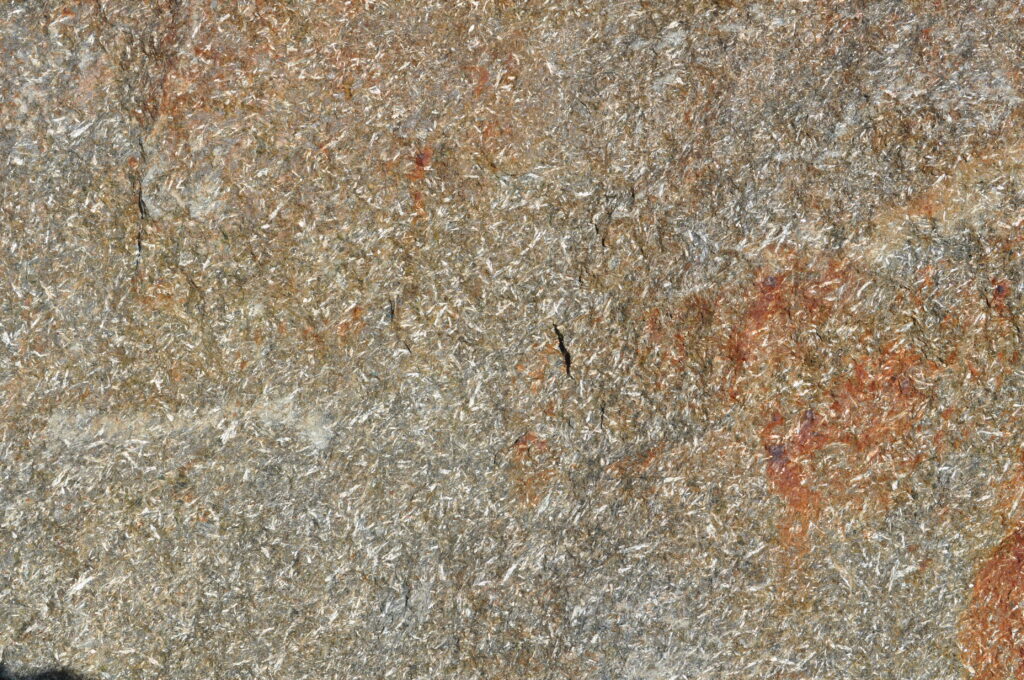
This is a second sample of an undefined ultramafic host rock that comes from the Kanichee Mine at Temagami, Ontario. Mineral content is unknown. Refer to UNGS#107.
NMO#16
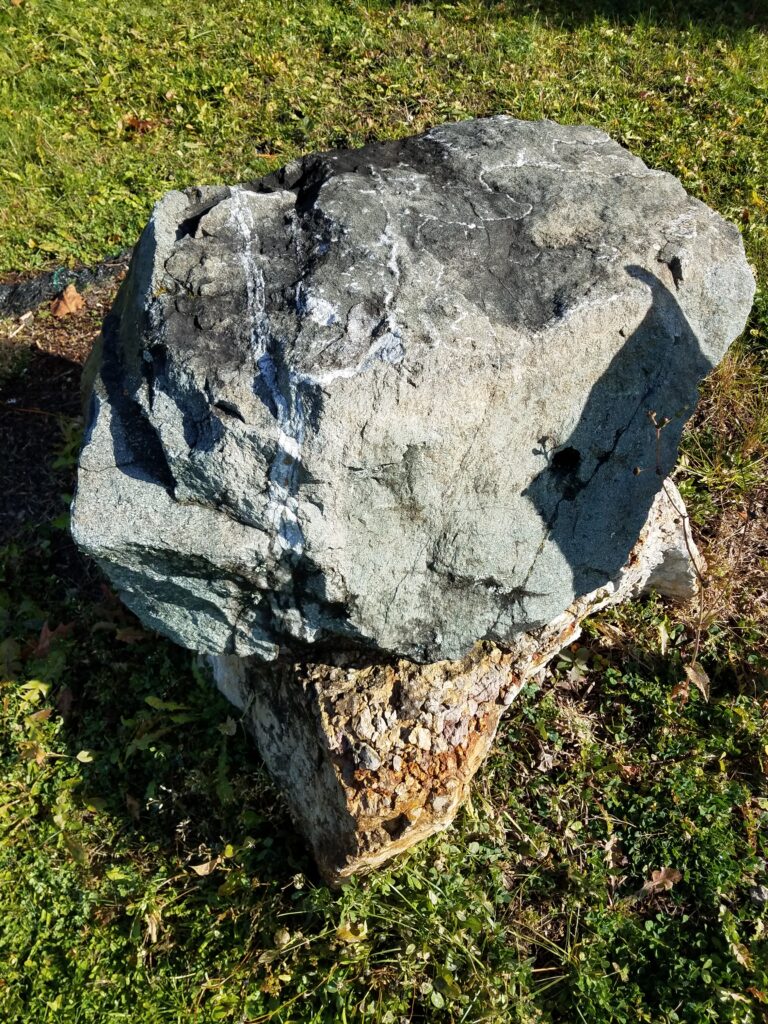
This is a Barren calcite vein and host rock from the Cobalt Mining Camp. This display was added because it shows a drill hole from the early 1900’s where the explosive did not ignite. This would be a danger factor that miners had to consider when re-drilling a rock to add new explosives. Although you can see remnants of the explosive packaging in the hole, there are no active explosive materials in this century old exhibit.
NMO#17
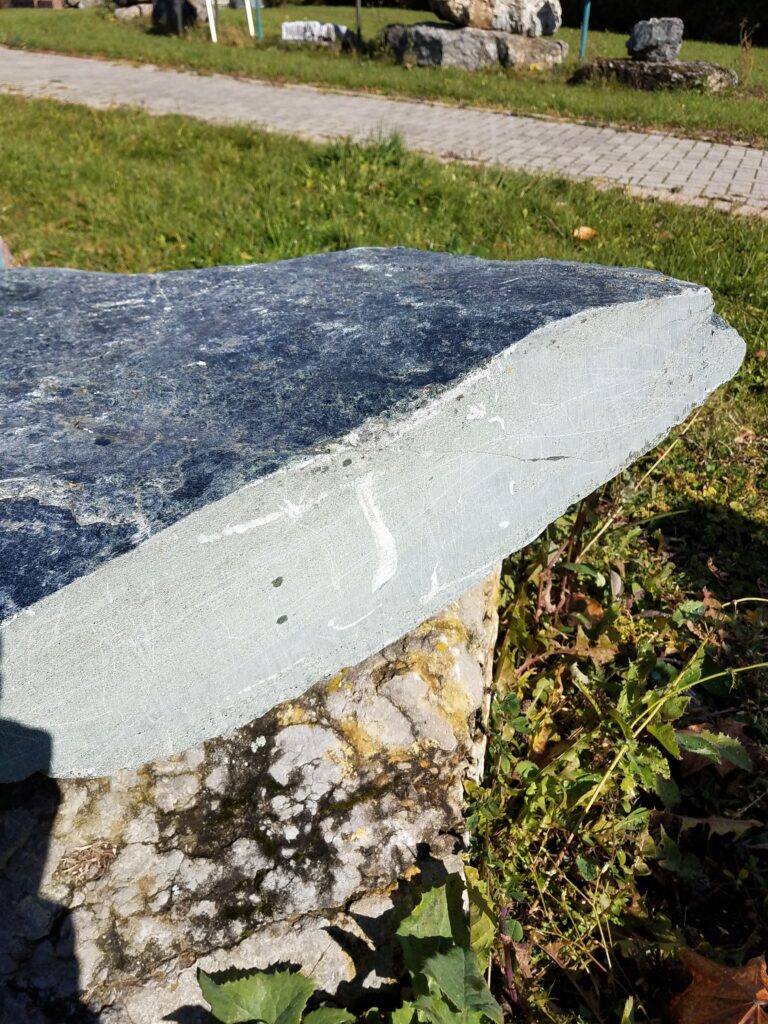
This sample is soapstone, from Les Pierres Steatites Inc., St. Pierre de Broughton, Quebec. As you can tell, this material is smooth, soft, and slippery, and typically is formed from massive aggregates of talc in low-grade metamorphic rock. This sample has been cut in half by a diamond saw to show the interior structure.
NMO#17A
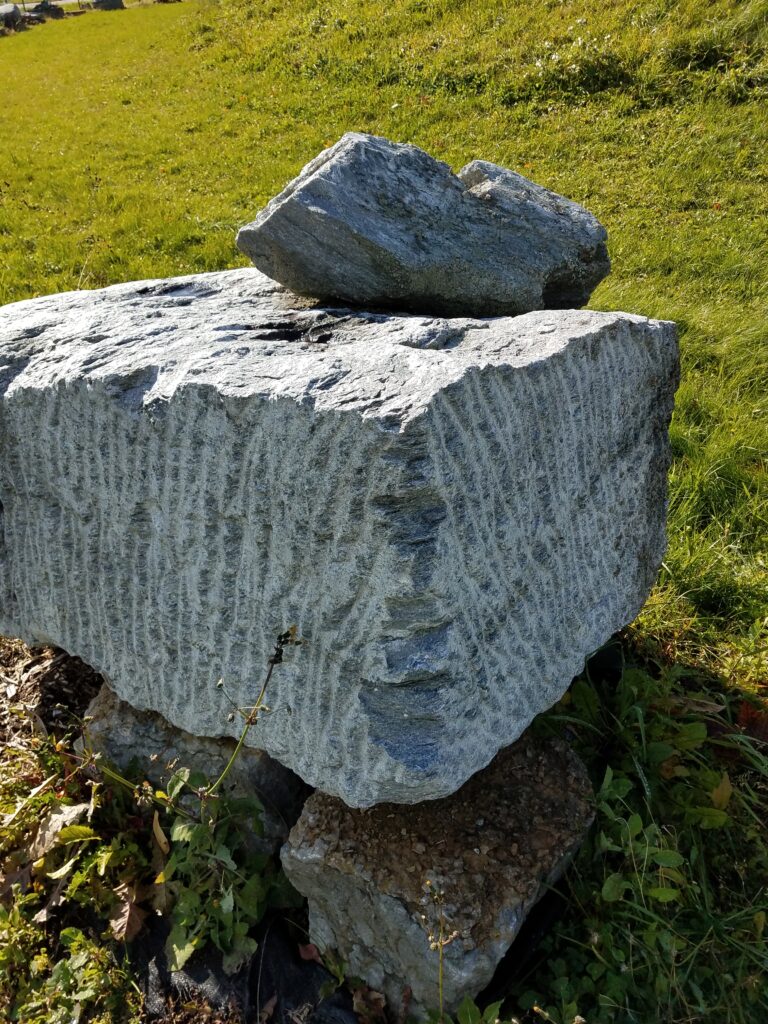
These two pieces are also from Les Pierres Steatites. The small one is high quality soapstone, the type used for sculpture. The large block is low grade Material and would be crushed, then reassembled as a fire resistant sheet-rock in housing construction, or used for refractory purposes such as foundry facings.
Internet mine photos…seek: Fraser Mine, East Broughton – mindat.org
NMO#19
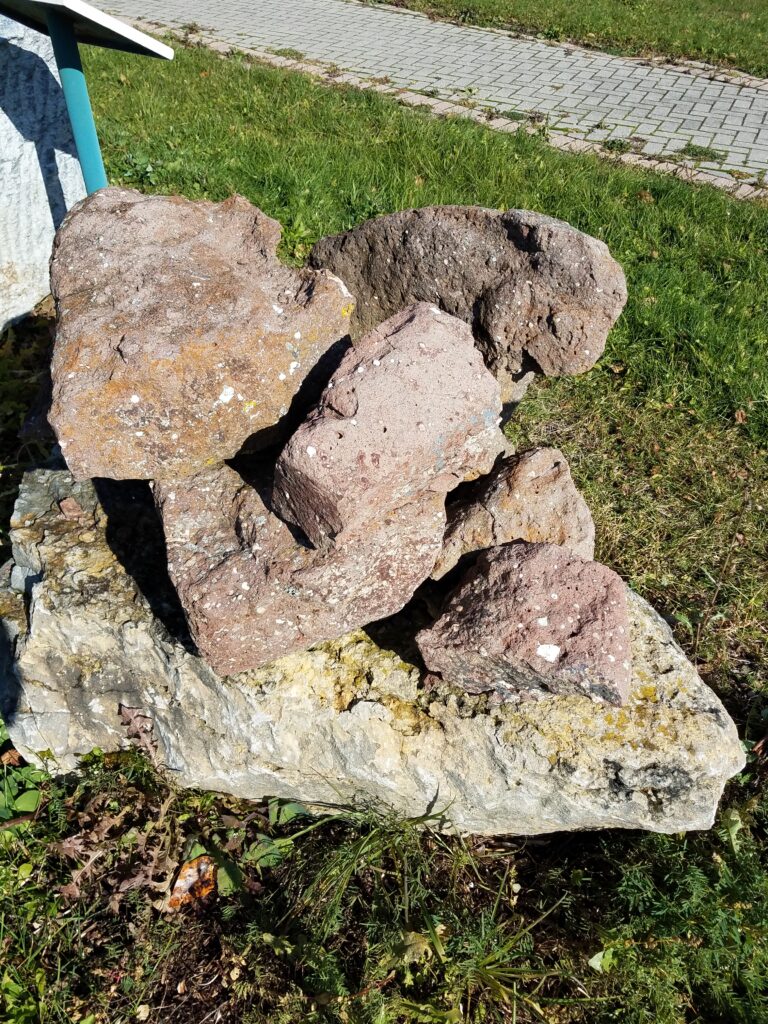
This specimen comes from C2C Resources, west of Kentville, Nova Scotia. There the land is underlain by extensive formations of vesicular basalt (basic volcanic rock containing gas bubbles). When the gas bubbles are filled with secondary minerals they are called amygdules, and the amygdules here are all examples of the family of minerals called zeolites. Zeolites have a sieve-like molecular structure, and so make excellent materials for softening water. During the spring and fall, the exposed holes from the original gas bubbles fill with water on warm days. At night, the water freezes and expands in size, eventually breaking what once was a large block of rock (at the Millennium) into continually smaller pieces. This is known as “Ice Wedging” and isa form of “mechanical weathering” and happens to all rocks.
Internet history…seek: Nova Scotian Mineral localities – North Mountain
NMO#24
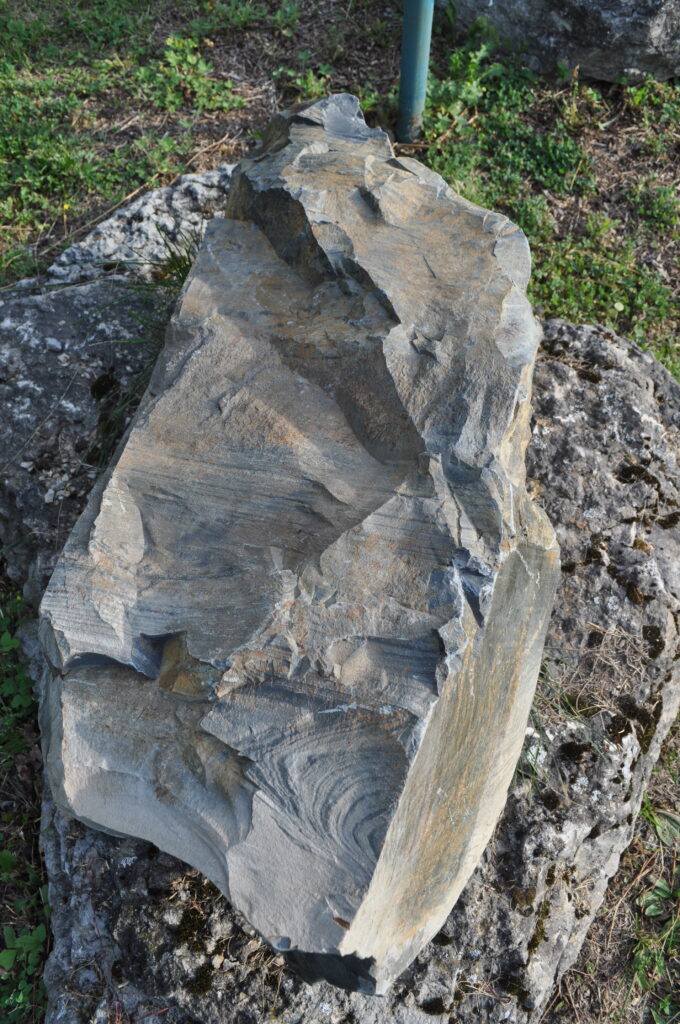
This is a Turbidite (formerly known as Slatey Greywacke) from Bucke Twp. (Hwy#11). Note the coloration and unusual layering pattern. Refer to LRT#4E, located nearby.
NMO#25
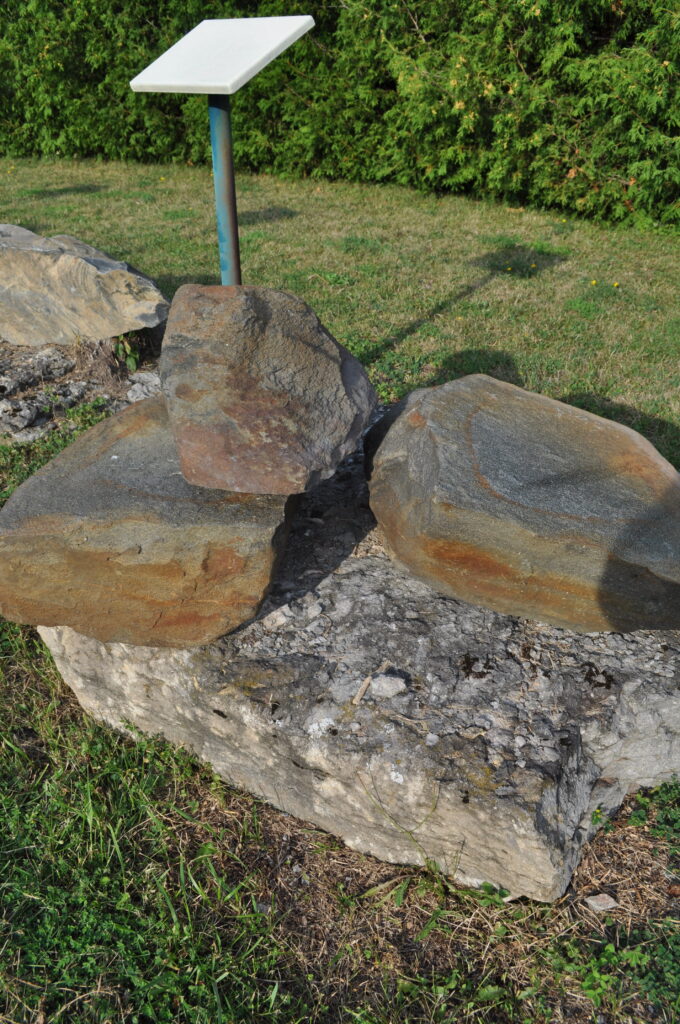
This is a medium grained metamorphic rock known for its “schistosity”. The rock is composed of mineral grains (that are easily seen) that are oriented in such a way that the rock is split into thin plates or even flakes. Referred to as “Schist”, it is most commonly made of mica minerals. However, industrial stones, such as Garnet and Kyanite can be found within (See GV#8, #9). The exhibit that you are now viewing shows the even splitting of the rock into three layers when it was transferred here.
Internet Humor…seek: Schist Happens: Get to Know this Brilliant Stone
NMO#26
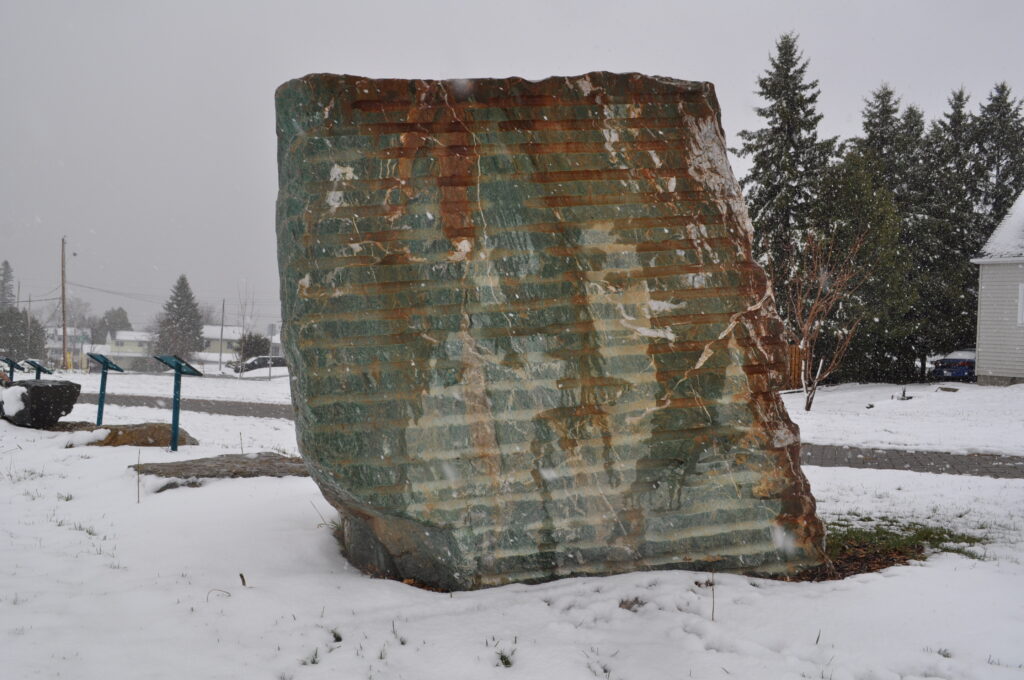
This exhibit is out of position. It is the large exhibit of “Dimension Stone” consisting of green fuschite mica, located at the south west corner of the park, across from the bus shelter. The exhibit came from a small open pit gold deposit near Virginiatown, ON. Determined to be barren of gold, it was removed from the pit by closely spaced pre-shear drilling, in which a very light charge of explosive was placed, just enough to separate the block from the pit wall. Note that some portions were cut away in the factory with diamond saws. The project went bankrupt before this exhibit was cut into slices destined to be table tops.
NMO#27A
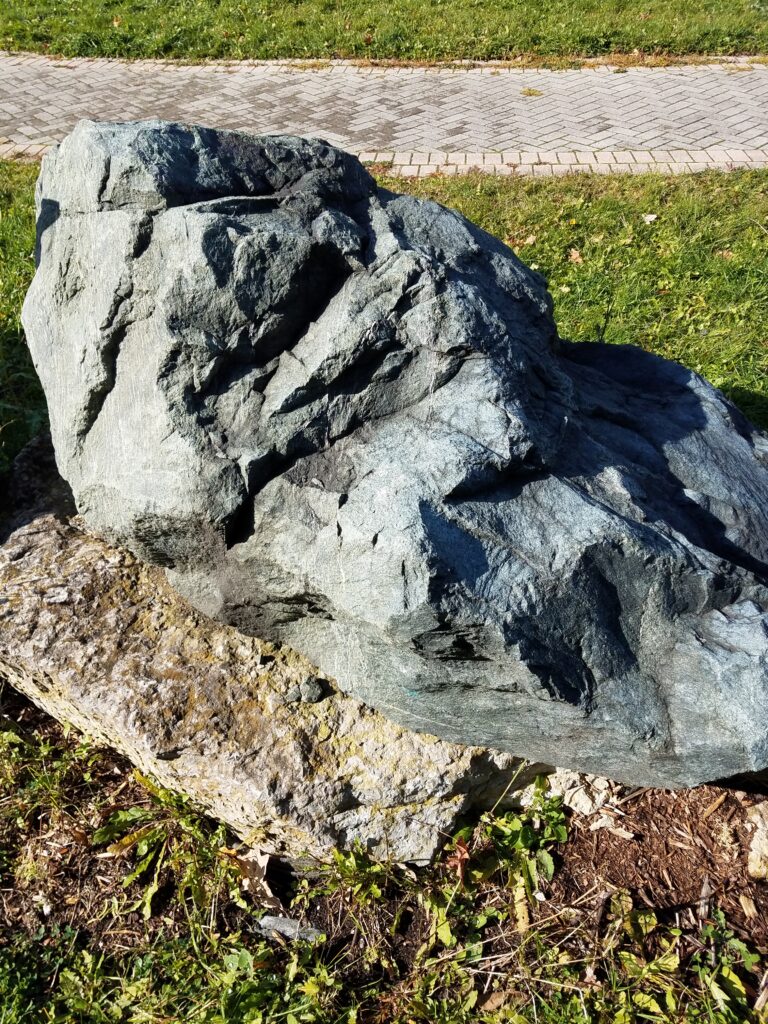
The next five samples are all examples of asbestos ore, to give an idea of the range and types of such ore available. This first black one comes from the Lloyd Lake ultramafic Complex of the Midlothian short fibre asbestos deposit near Matachewan. It alters from the barren dark host material (peridotite) into a low-grade ore, seen as narrow veinlets of short fibre in the greenish colored dunite (90% olivine). Generally, the longer the fibre, the more valuable is the ore. As many of you know, the extraordinary properties of asbestos, in relation to its incombustibility and its slow conductivity of heat, made it a favourite material for fireproofing, and insulation against heat and electricity (e.g. brake linings). A lot of media coverage has been devoted to the health hazards of asbestos. However, no distinction has been made between ‘white’ asbestos (all the samples exhibited here) and ‘blue’ asbestos (the much greater health hazard), or between dusty occupational settings (e.g. mines and asbestos board manufacturing plants) and non-occupational settings (e.g. office buildings with asbestos ceiling & floor tiles). Recent (post millennium) data do not support the concept that low-level (i.e. non-occupational) exposure to asbestos is health hazard in buildings and schools. One should also keep in mind that a low-level background of fibres is present globally, in the air and water, as a result of natural weathering of rocks with fibrous minerals.
Signage sponsored by Stratum (mining) Group, Timmins, Ontario
Internet Ontario Laws…seek: Designated Substance Asbestos Reg 278/05
NMO#27B
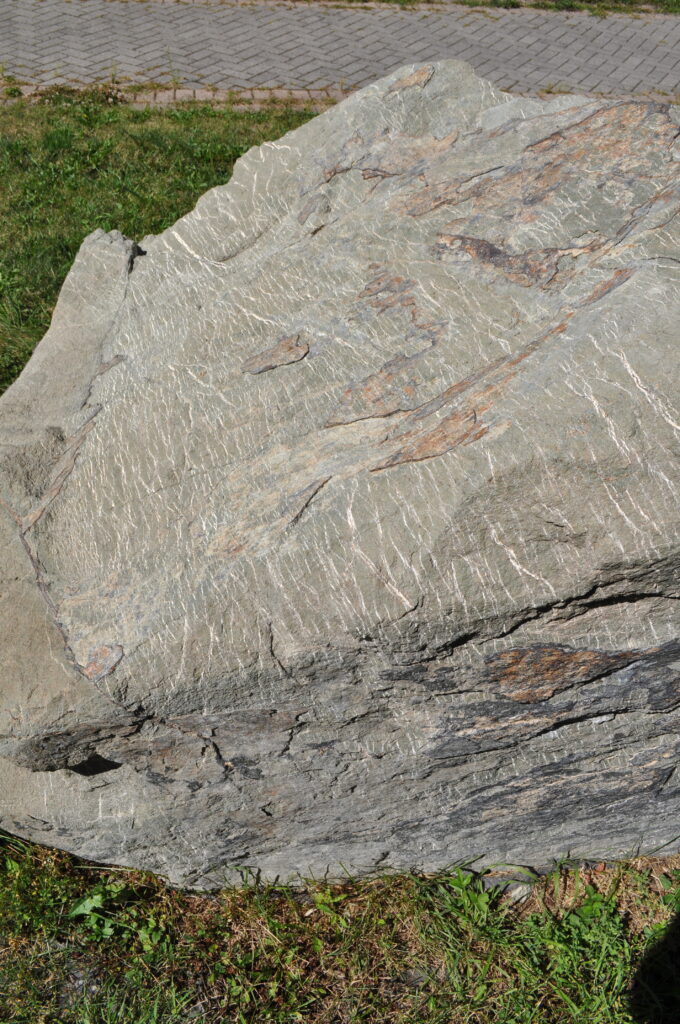
This green dunite sample comes from the core of the Midlothian deposit near Matachewan. The asbestos veinlets are composed of short fibre asbestos, and cut through an ultramafic rock that has been extensively altered to serpentine, talc, and chlorite. The deposit was found by surface exploration in the 1920’s, and diamond drilling defined the outline of the ore body by 1973. There was the potential for 150 million tons of ore, at a grade of 4.5% fibre (then valued at $554/ton). A $60 million mine and mill produced about 25,000 tons of high strength fibre between October 1975 and March 1977. That year brought economic, environmental, and political concerns about asbestos that quickly closed the entire operation.
Signage sponsored by Stratum (mining) Group, Timmins, Ontario
Internet Geology…seek: Dunite – Alex Strekeisen
NMO#27C
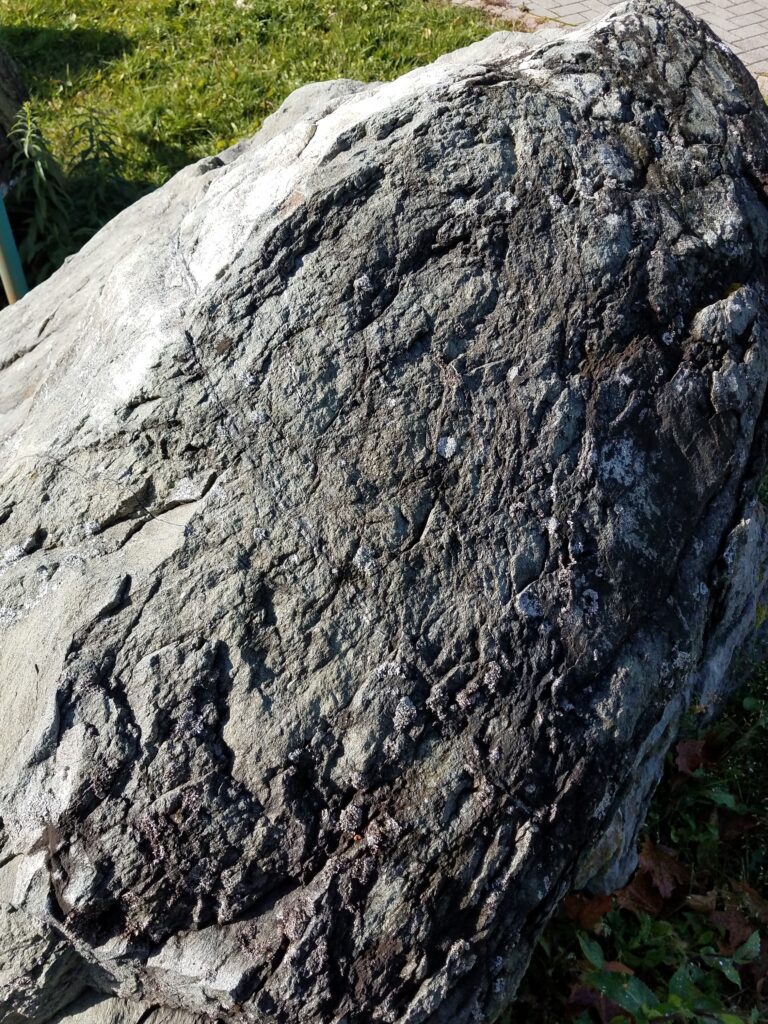
Again, you see a sample from Midlothian Mine near Matachewan. This time, however, the specimen illustrates the effect of glaciation on the north surface of this relatively soft rock-type. Asbestos is a commercial term for 6 different types of minerals… chrysotile, amosite, crocidolite, tremolite, anthophyllite, and actinolite. Asbestos is traditionally known for its slow conductivity of heat and incombustibility. It is a natural component of Canadian geology, and has no associated hazard in its natural form, as is exhibited here. This sample shows a glaciated surface that was eroded 10,000 years ago. Health risk is elevated from microscopic fibres that are released by manufacturing activity, resulting in a ban on the use of all asbestos. View another glaciated asbestos exhibit at UNGS#5.
Signage sponsored by Stratum (mining) Group, Timmins, Ontario
Internet geology history…seek: MNDM United Asbestos Deposit
NMO27D1
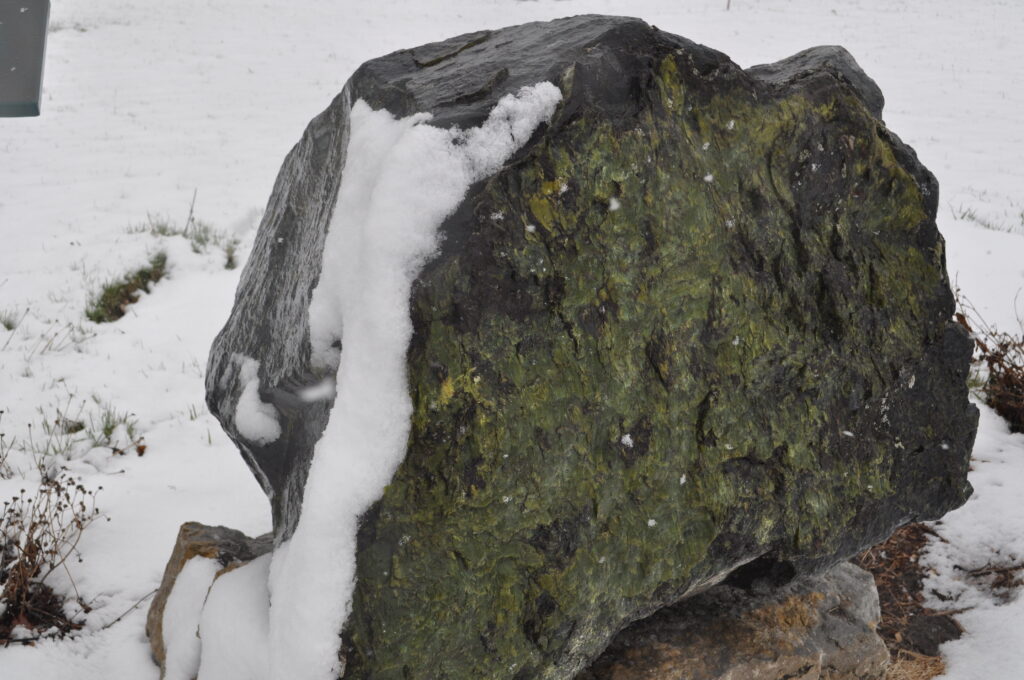
Munro Township, east and northeast of Matheson, Ontario, was the site for a Johns-Manville asbestos mining operation, and is now marked by a large hill of tailings visible from a great distance. This sample is an example of the asbestos ore, with longer fibre lengths being visible.
Internet Coordinates…seek: mindat.org Munro mine, Cochrane District
NMO#27D2
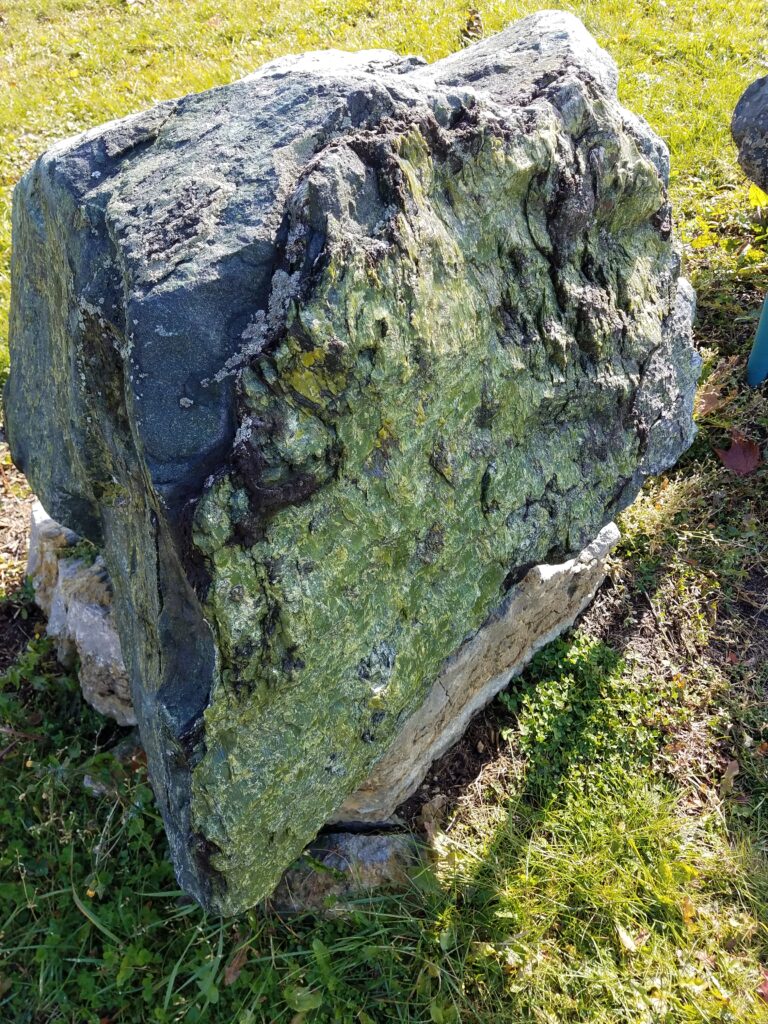
Here is a second sample from the Johns-Manville operation listed above. Note the thickness of the asbestos vein in comparison to the veinlets in the previous Midlothian deposit exhibits.”
NMO#27E
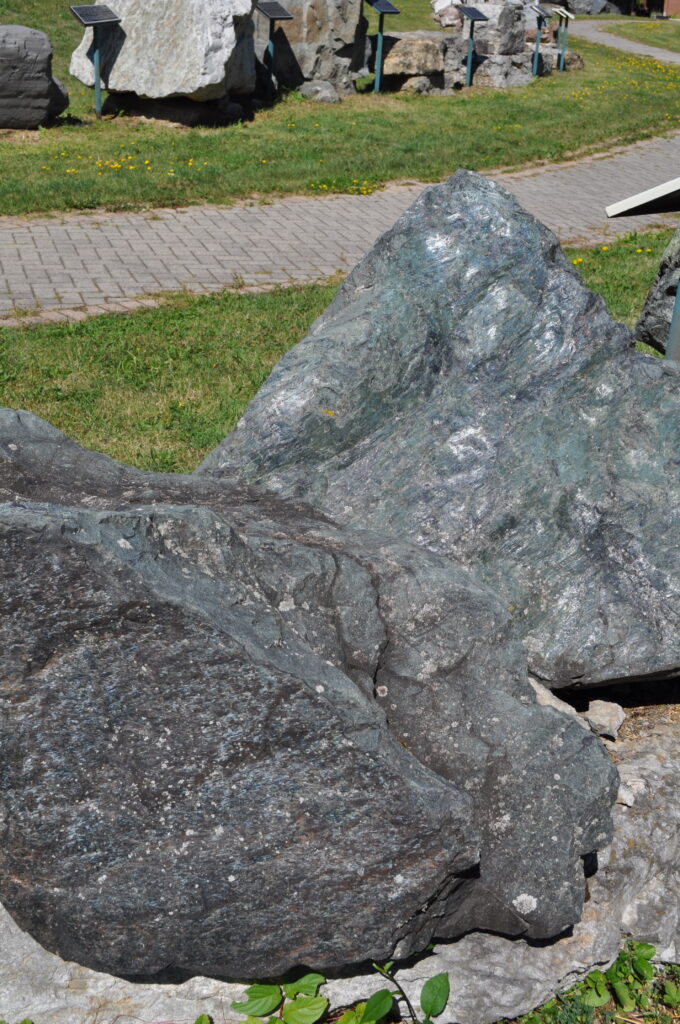
Another asbestos RELATED deposit in Munro Township, near Matheson, is the SERPENTINE Hedman deposit, from the 1960’s and 70’s. The host rock is ultramafic, with the specific name of lizardite, due to its visual representation of a snakes skin. Here, we have two samples on the one pedestal. Lizardite-serpentinite can occasionally be used as a mineral filler, meaning it provides bulk in certain manufactured materials used, for example, in construction and gardening.
NMO#30
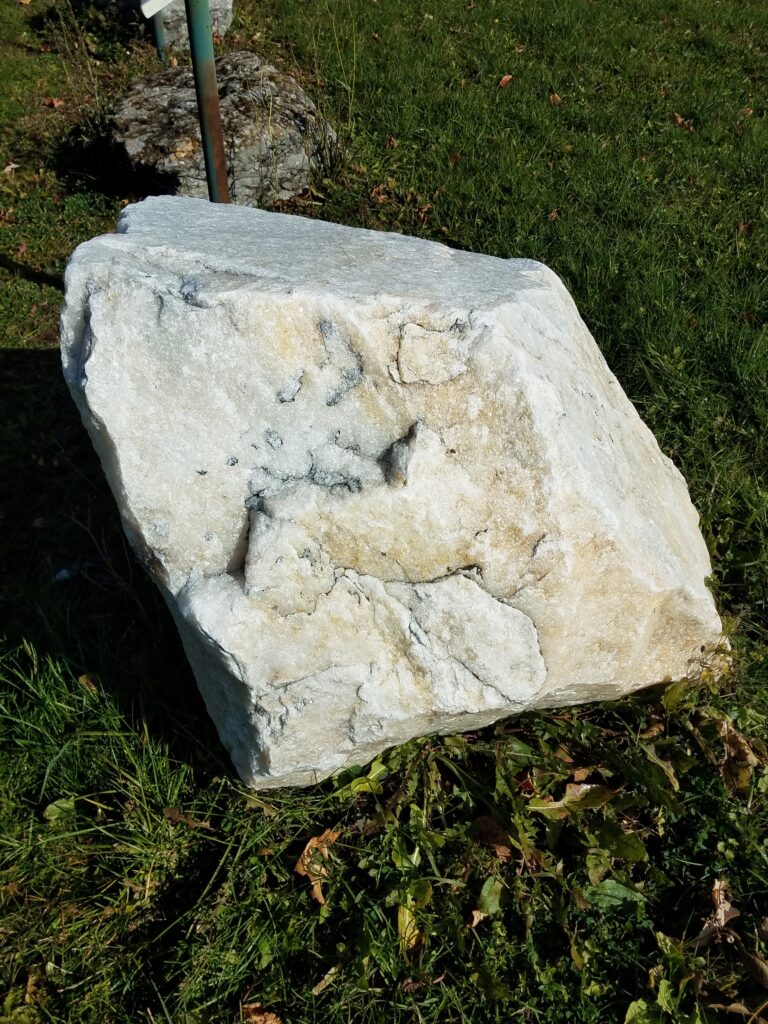
This rather innocuous- looking sample is silica from a mining property at Labrador City, Newfoundland & Labrador. Silica occurs in many forms (i.e. quartz, chert or jasper in banded iron formation), but as the principal material of either pure sandstone or quartzite, it can be easily mined or quarried to yield large tonnage. Although one of the most common of mineral commodities, it is also one of the most needed, to make computer chips, watch crystals, glass, etc. For example, a large tonnage of this material was shipped to Brazil in 2000 to test its silica values for making computer chips. Unfortunately, it proved unsatisfactory. Compare this quartzite sample to other quartz exhibits here at RockWalk Park.
Signage dedicated to Rev. Sherry De Jonge, Anglican Church of Canada
Internet…seek: What is silicon, and why are computer chips made from it?